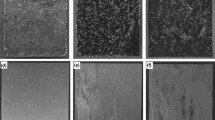Abstract
The influence of temperature and flow rate on the oxidation of 304L steel in O2/H2O mixtures was investigated. Polished samples were isothermally exposed to dry O2 and O2+40% H2O at 500–800°C at 0.02–13 cm/sec flow velocity, for 168 hr. The samples were analyzed by gravimetry, XRD, ESEM/EDX, and AES depth profiling. The oxidation of 304L in water vapor/oxygen mixtures at 500–800°C is strongly influenced by chromium evaporation. The loss of chromium tends to convert the protective chromia-rich oxide initially formed into a poorly protective, iron-rich oxide. The rate of oxidation depends on flow rate; high flow rates result in an early breakdown of the protective oxide. The most rapid breakdown of the protective oxide occurs at the highest temperature (800°C) and the highest gas flow (4000 ml/min=13 cm/sec). The oxide formed close to grain boundaries in the metal is more protective, while other parts, grain surfaces suffer breakaway corrosion. The protective oxide consists of a Cr-rich 50–200-nm thick M2O3 film, while the parts experiencing breakaway corrosion form a 10–30-μm thick Fe-rich M2O3/M3O4 scale. The results show that chromium evaporation is a key process affecting the oxidation resistance of chromia formers and marginal chromia formers in O2/H2O mixtures.
Similar content being viewed by others
REFERENCES
C. T. Fujii and R. A. Meussner, J. Electrochem. Soc. 111, 1215 (1964).
A. S. Khanna and P. Kofstad, Intern. Conf. Microscopy Oxidation (Institute of Materials, London, 1990), p. 113.
P. Kofstad, High-Temperature Corrosion (Chap. 11, Elsevier Applied Science, London, 1988), pp. 382-385.
G. Hultquist, G. K. Chuah, and K. L. Tan, Corros. Sci. 31, 149 (1990).
A. Holt and P. Kofstad, Solid State Ionics 69, 137 (1994).
H. C. Graham and H. H. Davies, J. Amer. Ceram. Soc. 54, 89 (1971).
H. Asteman, J.-E. Svensson, L.-G. Johansson, and M. Norell, Oxid. Met. 52, 161 (1999).
C. S. Tedmond, Jr., J. Electrochem. Soc. 113, 766 (1966).
H. Asteman, J.-E. Svensson, M. Norell, and L.-G. Johansson, Oxid. Met. 4, 11 (2000).
B. B. Ebbinghaus, Combustion Flame 93, 119 (1993).
Jun Eu Tang, M. Halvarsson, H. Asteman, and J.-E. Svensson, Micron, in press.
I. G. Wright, Metals Handbook, Vol. 13, Corrosion, 9th edn (ASM, Materials Park, OH, 1987), p. 97.
R. E. Lobnig, H. P. Schmidt, K. Hennesen, and H. J. Grabke, Oxid. Met. 37, 81 (1992).
C. Piehl, Zs. Toekei, and H. J. Grabke, Mater. High Temp. 2, 243 (2000).
A. Rahmel and J. Tobolski, Corros. Sci. 5, 333 (1965).
M. Thiele, H. Teichmann, W. Schwarz, and W. J. Quadakkers, VGB Kraftwerkstechnik, p. 77 (1997).
Author information
Authors and Affiliations
Rights and permissions
About this article
Cite this article
Asteman, H., Svensson, JE. & Johansson, LG. Evidence for Chromium Evaporation Influencing the Oxidation of 304L: The Effect of Temperature and Flow Rate. Oxidation of Metals 57, 193–216 (2002). https://doi.org/10.1023/A:1014877600235
Issue Date:
DOI: https://doi.org/10.1023/A:1014877600235




